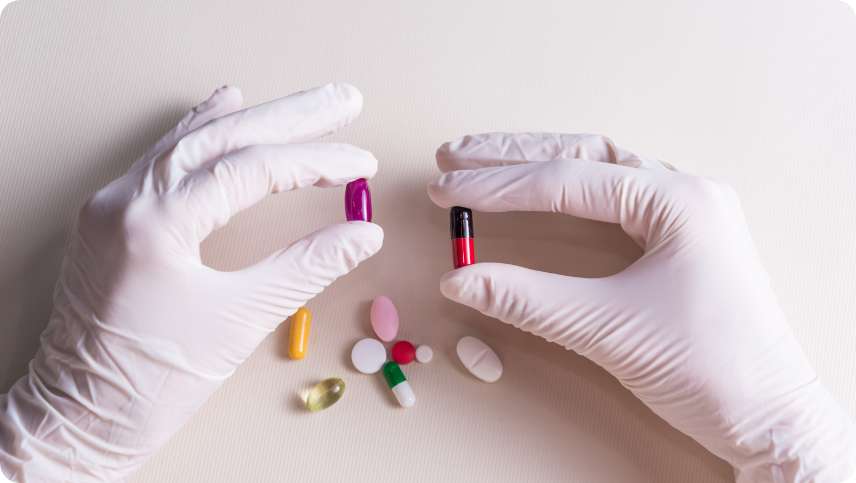
Both Famotidine (Pepcid) and Omeprazole (Prilosec) are common medications used to treat gastroesophageal reflux disease (GERD) and “acid reflux.” Both medications are extremely effective at helping to assist with both GERD and acid reflux. However, there are some key differences between the two medications. Differences include side effects, effectiveness, and price.
Key Takeaways
Both Famotidine (Pepcid) and Omeprazole (Prilosec) are extremely effective at treating gastrointestinal issues. However, there are some differences. For example, Prilosec is in a class of drugs called “PPIs,” while Pepcid is considered an H2 blocker.
The prices of both medications are generally very similar, especially after coverage with most insurers. However, since both of these options are considered “over-the-counter” medications, most patients opt to purchase these medications out-of-pocket.
A clinical trial performed in 2005 compared the effectiveness of both drugs treating non-erosive gastro-oesophageal reflux disease (GERD) in 98 Japanese patients. These patients were randomly assigned to receive one of the drugs (famotidine or omeprazole). The results of the study showed that Omeprazole provided better symptom relief overall, especially in H. pylori-negative patients. However, both drugs significantly improved health-related quality of life for those suffering gastrointestinal issues.
Famotidine (Pepcid) Dosage, Side Effects, and Use
Based on the label provided by the FDA, Pepcid (Famotidine) can be broken down into the following key parts:
Category | Details |
Initial U.S. Approval | 1986 |
Indications and Usage | In adults and pediatric patients ≥40 kg: treatment of active duodenal ulcer, active gastric ulcer, symptomatic non-erosive GERD, erosive esophagitis due to GERD. In adults: treatment of pathological hypersecretory conditions, reduction of risk of DU recurrence. |
Active Duodenal Ulcer Treatment | 40 mg once daily or 20 mg twice daily. |
Active Gastric Ulcer Treatment | 40 mg once daily. |
GERD Treatment | 20 mg twice daily. |
Erosive Esophagitis Treatment | 20 mg twice daily or 40 mg twice daily. |
Pathological Hypersecretory Conditions | 20 mg every 6 hours, adjust to patient needs, max 160 mg every 6 hours. |
Risk Reduction of DU Recurrence | 20 mg once daily. |
Administration | Take once daily before bedtime or twice daily in the morning and before bedtime, with or without food. |
Dosage Forms and Strengths | Tablets: 20 mg, 40 mg. |
Contraindications | History of serious hypersensitivity reactions to famotidine or other H2 receptor antagonists. |
Warnings and Precautions | CNS adverse reactions in elderly and renal impairment patients; risk of GI malignancy despite absence of symptoms; evaluate prior to therapy. |
Adverse Reactions | Common: headache, dizziness, constipation, diarrhea. |
Drug Interactions | Avoid taking any other drugs dependent on gastric pH for absorption, tizanidine (CYP1A2 substrate). |
Use in Specific Populations | Geriatric: use lowest effective dose and monitor renal function. Renal Impairment: reduce dosage due to CNS adverse reactions and QT prolongation risks. |
Prilosec (Omeprazole) Dosage, Side Effects, and Use
Based on the label provided by the FDA, Prilosec (Omeprazole) can be broken down into the following key parts:
Category | Details |
Initial U.S. Approval | 1989 |
Indications and Usage | Treatment of duodenal ulcer, gastric ulcer, GERD, maintenance of healing of erosive esophagitis. Not established for pediatric patients <1 year. |
Duodenal Ulcer Treatment | 20 mg once daily for 4 weeks. May require an additional 4 weeks of treatment. |
H. pylori Eradication Treatment | Triple Therapy: 20 mg Omeprazole, 1000 mg Amoxicillin, 500 mg Clarithromycin twice daily for 10 days. Dual Therapy: 40 mg Omeprazole once daily, 500 mg Clarithromycin three times daily for 14 days. |
Gastric Ulcer Treatment | 40 mg once daily for 4 to 8 weeks. |
GERD Treatment | 20 mg once daily for 4 to 8 weeks. |
Maintenance of Erosive Esophagitis | 20 mg once daily. |
Hypersecretory Condition Treatment | 60 mg (varies) once daily. |
Pediatric Patients (1-16 years) | GERD and Maintenance of Erosive Esophagitis: 5 mg (<10 kg), 10 mg (10-20 kg), 20 mg (>20 kg) once daily. |
Dosage Forms and Strengths | Capsules: 10 mg, 20 mg, 40 mg; Oral Suspension: 2.5 mg, 10 mg. |
Contraindications | Hypersensitivity to components, substituted benzimidazoles (e.g., angioedema, anaphylaxis). |
Warnings and Precautions | Possible gastric malignancy, atrophic gastritis, Clostridium difficile-associated diarrhea, bone fractures, diminished clopidogrel activity, hypomagnesemia, avoid with St. John's Wort or rifampin, diagnostic interactions. |
Adverse Reactions | Adults: headache, abdominal pain, nausea, diarrhea, vomiting, flatulence. Pediatrics: similar to adults, with additional respiratory events and fever. |
Drug Interactions | Atazanavir, nelfinavir (reduced levels); saquinavir (increased levels); effects drugs with gastric pH-dependent bioavailability; monitor with digoxin, warfarin, CYP 2C19/3A4 inhibitors, tacrolimus, methotrexate. |
Use in Specific Populations | Consider dose reduction in patients with hepatic impairment, especially for maintenance of erosive esophagitis. |
PPI Medications and H2 Blockers
Both Omeprazole and Famotidine are in a class of over-the-counter drugs. One of the medications belongs in a class of Proton Pump Inhibitors (PPIs) while another belongs in a class of H2 Blockers (H2-receptor antagonists). Making them effective at treating issues like Gastroesophageal Reflux Disease (GERD), peptic ulcer disease, zollinger-ellison syndrome, and erosive esophagitis.
Here is a breakdown of the key differences in PPIs and H2 blockers.
Proton Pump Inhibitors (PPIs)
Omeprazole is in a class of Proton Pump Inhibitors (PPIs). These PPIs are a class of medications that work by directly blocking the proton pump in a patient's stomach lining, which is directly responsible for secreting the gastric acid in the stomach. By inhibiting this pump, PPIs reduce the overall production of stomach acid.
This makes them highly effective for treating conditions related to excess stomach acid, such as:
Gastroesophageal Reflux Disease (GERD)
Peptic Ulcer Disease
Zollinger-Ellison Syndrome
Erosive Esophagitis
PPIs are often prescribed for both short-term and long-term treatment of these types of conditions due to their potent acid-suppressing abilities.
H2 Blockers (H2-Receptor Antagonists)
Famotidine belongs to a class of drugs known as H2 blockers or H2-receptor antagonists. These medications work by blocking histamine H2 receptors in the stomach lining, which play a role in signaling the production of gastric acid. By inhibiting these receptors, H2 blockers reduce the production of stomach acid.
They are used to treat conditions such as:
Gastroesophageal Reflux Disease (GERD)
Peptic Ulcer Disease
Gastric Ulcers
Hypersecretory Conditions
H2 blockers are generally effective in the short term, but they may be less effective than PPIs for long-term treatment due to the body developing tolerance, which can lead to a reduced response over time.
Feature | Omeprazole (PPI) | Famotidine (H2 Blocker) |
Mechanism of Action | Inhibits the proton pump in stomach lining | Blocks H2 receptors in stomach lining |
Effectiveness | Highly effective, especially for long-term use | Effective, but may develop tolerance over time |
Side Effects | Potential for more gastrointestinal side effects | Fewer side effects, but can include headaches and dizziness |
Long-term Risks | Potential for nutrient deficiencies, kidney issues, and infections | Generally considered safer for long-term use |
Omeprazole (Pepcid) and Famotidine (Prilosec) Comparison Overview
Here is a general overview of the similarities and differences between the two medications:
Medication | Dosage | Retail Price | Insurance Coverage | Medicare Copay | Common Side Effects |
Omeprazole (Pepcid) | 20 mg capsules (30 qty) | ~$100 per supply | Typically covered by insurance | $0–$19 | Headache, stomach pain, nausea, vomiting, constipation, diarrhea, dizziness, fatigue, gas |
Famotidine (Prilosec) | 20 mg tablets (60 qty) | ~$14.93 (6 tablets) | Typically covered by insurance | $0–$21 | Headache, dizziness, constipation, diarrhea, nausea, vomiting, muscle pain, decreased libido, dry mouth, fatigue |
Omeprazole is generally a little more expensive than Famotidine but is often covered by insurance and Medicare. Depending on your coverage, this can greatly reduce the out-of-pocket cost. For example, some discounts are available at online retailers that can bring down the total out-of-pocket cost to only around $2.
Famotidine is cheaper, with retail prices for a standard supply being around $14.93, and similar discount options bringing the cost down to about $3 at some retailers.
Both medications are generally covered by insurance and Medicare, making them accessible for most patients. The copay amounts vary slightly, with omeprazole generally being a bit cheaper on Medicare.
The side effects for both medications are somewhat similar, with omeprazole having a slightly broader range of potential gastrointestinal side effects. Famotidine is noted to have fewer long-term risks compared to omeprazole.
Effectiveness of Omeprazole (Pepcid) and Famotidine (Prilosec)
A clinical trial performed in 2005 compared the effectiveness of famotidine and omeprazole in treating non-erosive gastro-oesophageal reflux disease (GERD) in 98 Japanese patients, where Helicobacter pylori (H. pylori) infection is more prevalent. These patients were randomly assigned to receive either famotidine or omeprazole. Omeprazole provided better symptom relief overall, especially in H. pylori-negative patients. Both drugs improved health-related quality of life.
The “H. pylori relief rate” in the table below refers to the percentage of patients achieving complete symptom relief based on their H. pylori infection status. In this study, H. pylori-positive patients had better relief rates with famotidine, while omeprazole was effective regardless of H. pylori status. A patient with a positive test result for Helicobacter pylori (H. pylori) indicates an infection with the bacteria that can cause stomach ulcers and peptic ulcer disease. The importance of testing patients with H. pylori would indicate a stronger need for relief.
Aspect | Famotidine | Omeprazole |
Patient Group | 48 | 50 |
Dosage | 20 mg b.d. | Once daily |
Complete Relief Rate | 48% (23 patients) | 56% (28 patients) |
H. pylori-Negative Relief Rate | 35% | Significantly improved regardless |
H. pylori-Positive Relief Rate | 64% | Significantly improved regardless |
Health-Related Quality of Life | Improved most scales | Improved most scales |
Reflux Score Improvement | Significant in H. pylori-positive | Significant regardless of H. pylori |
Conclusion | Less effective in H. pylori-negative, similar efficacy in H. pylori-positive | More effective in H. pylori-negative, similar efficacy in H. pylori-positive |
Common Questions
Questions about both medications:
Can I take omeprazole and famotidine together?
There are no current and distinguished negative drug interactions between omeprazole and famotidine. Meaning that in some cases, omeprazole and famotidine can be used together. While PPIs are usually sufficient to treat digestive disorders like GERD, some people may need extra treatment to manage and control acid production at night (H2 blockers).
Securely Shop for Prescriptions From Canada and other International Pharmacies at Drugmart.com When you shop at Drugmart.com, you benefit from lower prescription drug prices without sacrificing safety. We pass on the savings from our trusted international partners' competitive pricing so that you can realize the value of pharmaceutical importation. Sign up and start safely importing prescription drugs for personal use today!
Sources
Kinoshita, Y., Adachi, K., Hongo, M., Haruma, K., & Kusano, M. (2005). Comparison of famotidine and omeprazole for non-erosive gastro-oesophageal reflux disease in Japanese patients: A randomized, double-blind, multicentre study. Alimentary Pharmacology & Therapeutics, 21(3), 277-285. https://pubmed.ncbi.nlm.nih.gov/15943841/
U.S. Food and Drug Administration. (2018). Prilosec (omeprazole) labeling.https://www.accessdata.fda.gov/drugsatfda_docs/label/2012/019810s096lbl.pdf
U.S. Food and Drug Administration. (2018). Pepcid (famotidine) labeling. https://www.accessdata.fda.gov/drugsatfda_docs/label/2018/019462s039lbl.pdf
Antunes C, et al. (2023). Gastroesophageal reflux disease. https://www.ncbi.nlm.nih.gov/books/NBK441938/
Famotidine. (2018). https://dailymed.nlm.nih.gov/dailymed/fda/fdaDrugXsl.cfm?setid=f67bcbc7-952c-61c0-e053-2a95a90a6fa6&type=display
Maideen NMP. (2023). Adverse effects associated with long-term use of proton pump inhibitors. https://www.ncbi.nlm.nih.gov/pmc/articles/PMC10248387/
Nguyen K, et al. (2022). Famotidine. https://www.ncbi.nlm.nih.gov/books/NBK534778/
Omeprazole. (2023). https://dailymed.nlm.nih.gov/dailymed/fda/fdaDrugXsl.cfm?setid=603d2d06-c5e8-4378-a422-8dca1a410af7&type=display
Shah N, et al. Omeprazole. (2023). https://www.ncbi.nlm.nih.gov/books/NBK539786/





